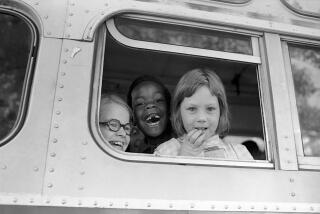School Vouchers Don’t Help Neediest Students
- Share via
It’s been nearly half a century since Milton Friedman first rattled the educational world with his radical proposal to use vouchers to offer choice to parents disaffected with their local public schools. Since then, his ideas have gained increasing acceptance.
Supporters of choice are convinced that only the existence of an open educational marketplace can rescue failing schools from the chokehold that vested interests exert, particularly on poor and minority students. By forcing schools to compete for students, they maintain, schools will improve or lose enrollment and go out of business.
Before the movement goes any further, it’s instructive to look at the experience of other countries with a history of choice. New Zealand and Chile stand out for having introduced the most far-reaching reforms.
In the early ‘90s, New Zealand undertook an ambitious project called Tomorrow’s Schools. Local schools were granted operational autonomy. Parents were given the right to choose any school, including a parochial school. Tuition, in the form of a voucher, followed students.
What happened in New Zealand was unexpected. The best schools rapidly filled up and began to turn away hard-to-teach students, mainly poor and minority. As a result, these students had nowhere to go but back to their schools of origin, which became significantly more polarized along ethnic and socioeconomic lines.
Realizing that its grand experiment wasn’t working as intended, New Zealand began to pull back. The country is still recovering from the fiasco.
Chile’s experiment with choice echoed New Zealand’s. After a military coup in 1973, the new government disbanded teachers unions and it decentralized school operations; some 300 municipalities were given responsibility for schools. Funding was provided to private and public schools on an equal basis.
Despite the freedom of choice created through vouchers, there was no consistent evidence of gains in academic achievement, even for low-income students. The only positive outcome of Chile’s experiment was that nonreligious voucher schools were found to be more cost-effective to operate, most likely because of lower teacher salaries.
What lessons can be drawn? Choice, with its reliance on competition and vouchers, makes little difference for those students who have been shortchanged the most by the traditional system. That’s because poor and minority children constitute a group that is hard to teach. They often go to school with huge deficits in socialization, motivation and academic preparedness. As a result, they can require a disproportionate amount of time, effort and money to educate.
In an open educational marketplace, where efficiency and productivity are prerequisites for success, they’re the students no one wants. Yet they have to be educated. Until a way is found to reach these students, they’ll continue to fall further behind. That’s the side of choice that myth makers in this country are not talking about.
More to Read
Sign up for Essential California
The most important California stories and recommendations in your inbox every morning.
You may occasionally receive promotional content from the Los Angeles Times.












